| |

|
Setup
|
Backgammon is a game for two players, played on a board consisting of twentyfour
triangles called points.
The points, alternating in color, are grouped into four quadrants.
The quadrants are referred to as a player's home board
and outer board. The opposite side, the opponent's home board and
outer board.
The home and outer boards are separated from each other by the bar down the
center of the board.
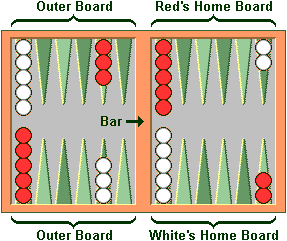 |
Figure 1.
A board with the checkers in their initial position of a standard play layout.
The orientation of the board is optional, for example, your home board can be in any corner.
|
The points are numbered, one to twentyfour, starting in the player's home board.
The outermost point is the twentyfour point, which is also the opponent's one
point.
There are fifteen checkers of the same color for each player.
The initial arrangement of checkers is:
2 on each player's twentyfour point, 5 on each player's thirteen point,
3 on each player's eight point, and 5 on each player's six point.
 Both players have a pair of dice and a dice-cup.
Optionally, a doubling cube,
with the numerals 2, 4, 8, 16, 32, and 64 on its
faces, can be used to increase and keep track of the current stake of the game.
Both players have a pair of dice and a dice-cup.
Optionally, a doubling cube,
with the numerals 2, 4, 8, 16, 32, and 64 on its
faces, can be used to increase and keep track of the current stake of the game.
|
|

|
Object of the Game
|
The object of the game is move all your checkers into your own home board and then
bear them off.
The first player to bear off all of their checkers wins the game.
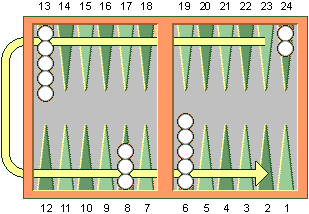 |
Figure 2.
Direction of movement of White's checkers.
Red's checkers move in the opposite direction.
|
|
|

|
Movement of the Checkers
|
To start the game, each player throws a single die.
This determines both the player to go first and the numbers to be played.
If equal numbers come up, then both players roll again until they roll
different numbers.
The player throwing the higher number now moves his checkers according to
the numbers showing on both dice.
After the first roll, the players throw two dice and alternate turns.
The roll of the dice indicates how many points, or pips,
the player is to move his checkers.
The checkers are always moved forward, to a lower-numbered point.
The following rules apply:
-
A checker may be moved to an open point, or to a point containing your own checkers, or to a point
that contains just one checker of the opposing player, a blot and thus a hit.
-
The numbers on the two dice constitute separate moves.
For example, if a player rolls 5 and 3, he may move one checker five
spaces to an open point and another checker three spaces to an open
point, or he may move the one checker a total of eight spaces to an
open point, but only if the intermediate point (either three or five
spaces from the starting point) is also open or contains just one checker of the opposing player.
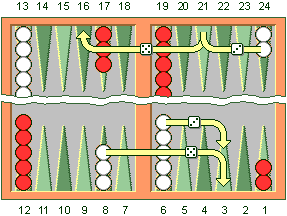 |
Figure 3.
Example of just two ways that White can play a roll of

|
-
A player who rolls doubles will play the numbers shown on the dice twice.
A roll of 6 and 6 means that the player has 4 sixes to use, and may move any combination of checkers.
-
A player must use both numbers of a roll if this is legally possible
(or all four numbers of a double).
When only one number can be played, the player must play that number.
Or if either number can be played but not both, the player must play
the larger one.
When neither number can be used, the player loses his turn.
In the case of doubles, when all four numbers cannot be played, the
player must play as many numbers as he can.
|
|

|
Hitting and Entering
|
A point occupied by a single checker of either color is called a blot.
If an opposing checker lands on a blot, the blot is hit and placed on the bar.
Any time a player has one or more checkers on the bar, his first obligation
is to enter those checkers into the opposing home board.
A checker is entered by moving it to an open point, or blot corresponding to one of
the numbers on the rolled dice.
For example, if a player rolls 4 and 6, he may enter a checker
onto either the opponent's four point or six point, so long as the
prospective point is not occupied by two or more of the opponent's checkers.
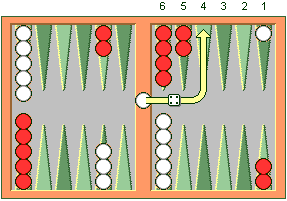 |
Figure 4.
If White rolls
 with a checker on the bar, he must enter the checker onto Red's four
point
since Red's six point is not open.
with a checker on the bar, he must enter the checker onto Red's four
point
since Red's six point is not open.
|
If neither of the points is open, the player loses his turn.
If a player is able to enter some but not all of his checkers, he must enter
as many as he can and then forfeit the remainder of his turn.
After the last of a player's checkers has been entered, any unused numbers
on the dice must be played, by moving either the checker that was entered
or a different checker.
|
|

|
Bearing Off
|
Once a player has moved all of his fifteen checkers into his home board,
he may commence bearing off.
A player bears off a checker by rolling a number that corresponds to the
point on which the checker resides, and then removing that checker from
the board.
Thus, rolling a 6 permits the player to remove a checker from the six point.
If there is no checker on the point indicated by the roll, the player
must make a legal move using a checker on a higher-numbered point.
If there are no checkers on higher-numbered points, the player is
permitted (and required) to remove a checker from the highest point on
which one of his checkers resides.
A player is under no obligation to bear off if he can make an otherwise
legal move.
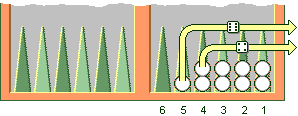 |
Figure 5.
White rolls
 and bears off two checkers.
and bears off two checkers.
|
A player must have all of his active checkers in his home board in order
to bear off.
If a checker is hit during the bear-off process, the player must bring
that checker back to his home board before continuing to bear off.
The first player to bear off all fifteen checkers wins the game.
|
|

|
Doubling
|
Backgammon is played for an agreed stake per point.
Each game starts at one point.
During the course of the game, a player who feels he has a sufficient
advantage may propose doubling the stakes.
He may do this only at the start of his own turn and before he has rolled
the dice.
A player who is offered a double may refuse, in
which case he concedes the game and pays one point.
Otherwise, he must accept the double and play on for the new higher stake.
A player who accepts a double becomes the owner of the cube and only
he may make the next double.
Subsequent doubles in the same game are called redoubles.
If a player refuses a redouble, he must pay the number of points that were
at stake prior to the redouble.
Otherwise, he becomes the new owner of the cube and the game continues at twice the previous stake.
There is no limit to the number of redoubles in a game.
|
|

|
Scoring Gammons and Backgammons
|
At the end of the game, if the losing player has borne off at least one
checker, he loses only the value showing on the doubling cube (a single point if there have been no doubles on the cube).
However, if the losing player has not borne off any checkers,
this is known as being gammoned and the loss value is twice the value of the doubling cube.
If the loser has not borne off any checkers and still has
a checker on the bar or in the winner's home board, he is backgammoned
and loses three times the value of the doubling cube.
|
|

|
Playing In Matches
|
The following are descriptions of Backgammon played in one of two rule sets.
-
Match-Play.
In match-play, the match is ended when one player reaches enough points to exceed the length of the match. In a 7-point match, the first player to win seven or more points, ends the match.
Common optional rule used in match-play is the Crawford rule.
-
Money-Play.
In money-play, the match is ended at the end of the last game that is the total length of the match. In a 7-point match, exactly seven games will be played before the match ends.
Common optional rules for money-play include the Jacoby and Beaver rules.
|
|

|
Optional Rules
|
The following optional rules are in widespread use.
-
Automatic doubles on Opening Roll.
If identical numbers are thrown on the first roll, the stakes are automatically doubled.
The doubling cube is turned to 2 and remains in the middle on the bar.
Players usually agree to limit the number of automatic doubles to one per game.
-
The Crawford Rule.
This rule applies to matches with the
doubling cube in use. When the leading
player comes within one point of winning the
match, the following game is played without a
doubling cube. This one game of the match is called the Crawford Game.
After the Crawford game, the doubling cube may be used again.
This rule avoids giving the losing player an unfair advantage of obtaining extra points by doubling the stakes.
-
Beavers.
Normally played in Money-Play matches.
When a player is doubled, he may immediately redouble (beaver) while
retaining possession of the cube.
The original doubler has the option of accepting or refusing as with a
normal double.
-
The Jacoby Rule.
Normally played in Money-Play matches.
Gammons and backgammons count only as a single game if neither player has
offered a double during the course of the game.
This rule speeds up play by eliminating situations where a player avoids
doubling so he can play on for a gammon.
-
The Dead Cube, or Frozen Cube, Rule.
The Dead Cube rule, also known as the Frozen Cube rule, is used normally in backgammon match-play.
The doubling-cube becomes frozen, can no longer be played, when the value of the cube is enough that either player could win the match.
|
|

|
Start Variants
|
|
SimplyBG.com supports 5 different starting position setups.
-
Standard Starting Position
The standard starting postion, checkers placed as (count-point) 2-25, 5-12, 3-17 and 5-19
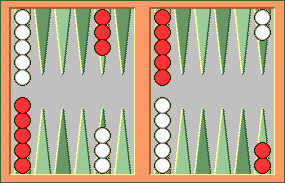 |
Figure 6.
Standard Backgammon Checker Setup.
|
-
Hyper Starting Position
The Hypergammon starting postion, using just 3 checkers placed on your 25 point.
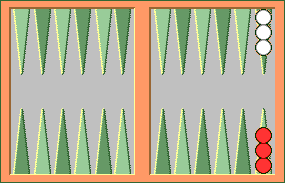 |
Figure 7.
Hypergammon Checker Setup.
|
-
Long Starting Position
The Longgammon starting postion, place all 15 checkers on your 25 point.
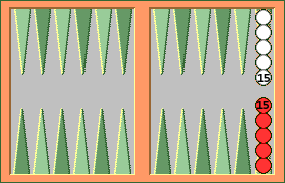 |
Figure 8.
Longgammon Checker Setup.
|
-
Nack Starting Position
The Nackgammon starting postion, place checkers as (count-point) 2-25, 2-24, 4-12, 3-17, 4-19.
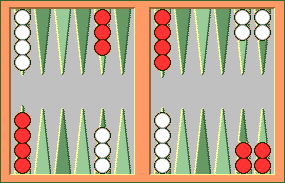 |
Figure 9.
Nackgammon Checker Setup.
|
-
Coup Classique Starting Position
From this seemingly unwinnable position in which your opponent has borne off twelve checkers and has just three checkers remaining on your 23-point. You begin with one checker on your 24-point, twelve checkers form a six point block on your opponent bar, and the remaining two checkers are on the twelve and thirteen points.
Winning a coup classique is especially satisfying for you and maddening for your opponent. A great way to discover the value of the checkers.
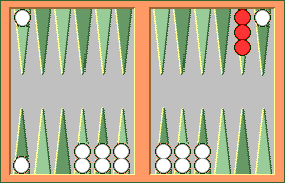 |
Figure 10.
Coup Classique Checker Setup.
|
|

|
Probability of Entering From the Bar
|
Below are the mathematical chances, or odds, of entering from the bar when your opponent has 0, 1, 2, 3, 4 or 5 points blocked. When 6 points are blocked, your odds are zero.
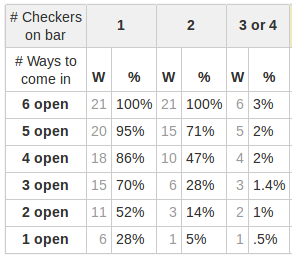 |
Figure 11.
Chart of probability of entering from the bar.
|
|

|
Irregularities in Face-to-Face Play
|
|
Although SimplyBG.com is an online play venue, for completeness we have included some standard face-to-face playing rules here.
-
The dice must be rolled together and land flat on the surface of the
right-hand section of the board.
The player must reroll both dice if a die lands outside the right-hand
board, or lands on a checker, or does not land flat.
-
A turn is completed when the player picks up his dice.
If the play is incomplete or otherwise illegal, the opponent has the option
of accepting the play as made or of requiring the player to make a legal play.
A play is deemed to have been accepted as made when the opponent rolls his
dice or offers a double to start his own turn.
-
If a player rolls before his opponent has completed his turn by picking up
the dice, the player's roll is voided.
This rule is generally waived any time a play is forced or when there is no
further contact between the opposing forces.
|
|
|


 Both players have a pair of dice and a dice-cup.
Optionally, a doubling cube,
with the numerals 2, 4, 8, 16, 32, and 64 on its
faces, can be used to increase and keep track of the current stake of the game.
Both players have a pair of dice and a dice-cup.
Optionally, a doubling cube,
with the numerals 2, 4, 8, 16, 32, and 64 on its
faces, can be used to increase and keep track of the current stake of the game.










